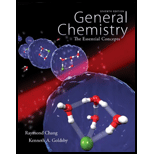
(a)
Interpretation:
An example of monoatomic cation has to be given.
Concept Introduction:
An ion is an individual atom or group of atoms has net positive charge or negative charge. Positively charged atom remains the same during
Monoatomic ion:
Monoatomic ion is the ion consists of only one atom.
Polyatomic ion:
Polyatomic ion is the ion consists of more than one atom of same element.
(b)
Interpretation:
An example of monoatomic anion has to be given.
Concept Introduction:
An ion is an individual atom or group of atoms has net positive charge or negative charge. Positively charged atom remains the same during chemical reaction (or change), however negatively charged atom may accept or donate an electrons. The loss of electrons result in cation.
Monoatomic ion:
Monoatomic ion is the ion consists of only one atom.
Polyatomic ion:
Polyatomic ion is the ion consists of more than one atom of same element.
(c)
Interpretation:
An example of polyatomic cation has to be given.
Concept Introduction:
An ion is an individual atom or group of atoms has net positive charge or negative charge. Positively charged atom remains the same during chemical reaction (or change), however negatively charged atom may accept or donate an electrons. The loss of electrons result in cation.
Monoatomic ion:
Monoatomic ion is the ion consists of only one atom.
Polyatomic ion:
Polyatomic ion is the ion consists of more than one atom of same element.
(d)
Interpretation:
An example of polyatomic anion has to be given.
Concept Introduction:
An ion is an individual atom or group of atoms has net positive charge or negative charge. Positively charged atom remains the same during chemical reaction (or change), however negatively charged atom may accept or donate an electrons. The loss of electrons result in cation.
Monoatomic ion:
Monoatomic ion is the ion consists of only one atom.
Polyatomic ion:
Polyatomic ion is the ion consists of more than one atom of same element.
Want to see the full answer?
Check out a sample textbook solution
Chapter 2 Solutions
Connect 2-Year Access Card for Chemistry: The Essential Concepts
 ChemistryChemistryISBN:9781305957404Author:Steven S. Zumdahl, Susan A. Zumdahl, Donald J. DeCostePublisher:Cengage Learning
ChemistryChemistryISBN:9781305957404Author:Steven S. Zumdahl, Susan A. Zumdahl, Donald J. DeCostePublisher:Cengage Learning ChemistryChemistryISBN:9781259911156Author:Raymond Chang Dr., Jason Overby ProfessorPublisher:McGraw-Hill Education
ChemistryChemistryISBN:9781259911156Author:Raymond Chang Dr., Jason Overby ProfessorPublisher:McGraw-Hill Education Principles of Instrumental AnalysisChemistryISBN:9781305577213Author:Douglas A. Skoog, F. James Holler, Stanley R. CrouchPublisher:Cengage Learning
Principles of Instrumental AnalysisChemistryISBN:9781305577213Author:Douglas A. Skoog, F. James Holler, Stanley R. CrouchPublisher:Cengage Learning Organic ChemistryChemistryISBN:9780078021558Author:Janice Gorzynski Smith Dr.Publisher:McGraw-Hill Education
Organic ChemistryChemistryISBN:9780078021558Author:Janice Gorzynski Smith Dr.Publisher:McGraw-Hill Education Chemistry: Principles and ReactionsChemistryISBN:9781305079373Author:William L. Masterton, Cecile N. HurleyPublisher:Cengage Learning
Chemistry: Principles and ReactionsChemistryISBN:9781305079373Author:William L. Masterton, Cecile N. HurleyPublisher:Cengage Learning Elementary Principles of Chemical Processes, Bind...ChemistryISBN:9781118431221Author:Richard M. Felder, Ronald W. Rousseau, Lisa G. BullardPublisher:WILEY
Elementary Principles of Chemical Processes, Bind...ChemistryISBN:9781118431221Author:Richard M. Felder, Ronald W. Rousseau, Lisa G. BullardPublisher:WILEY





